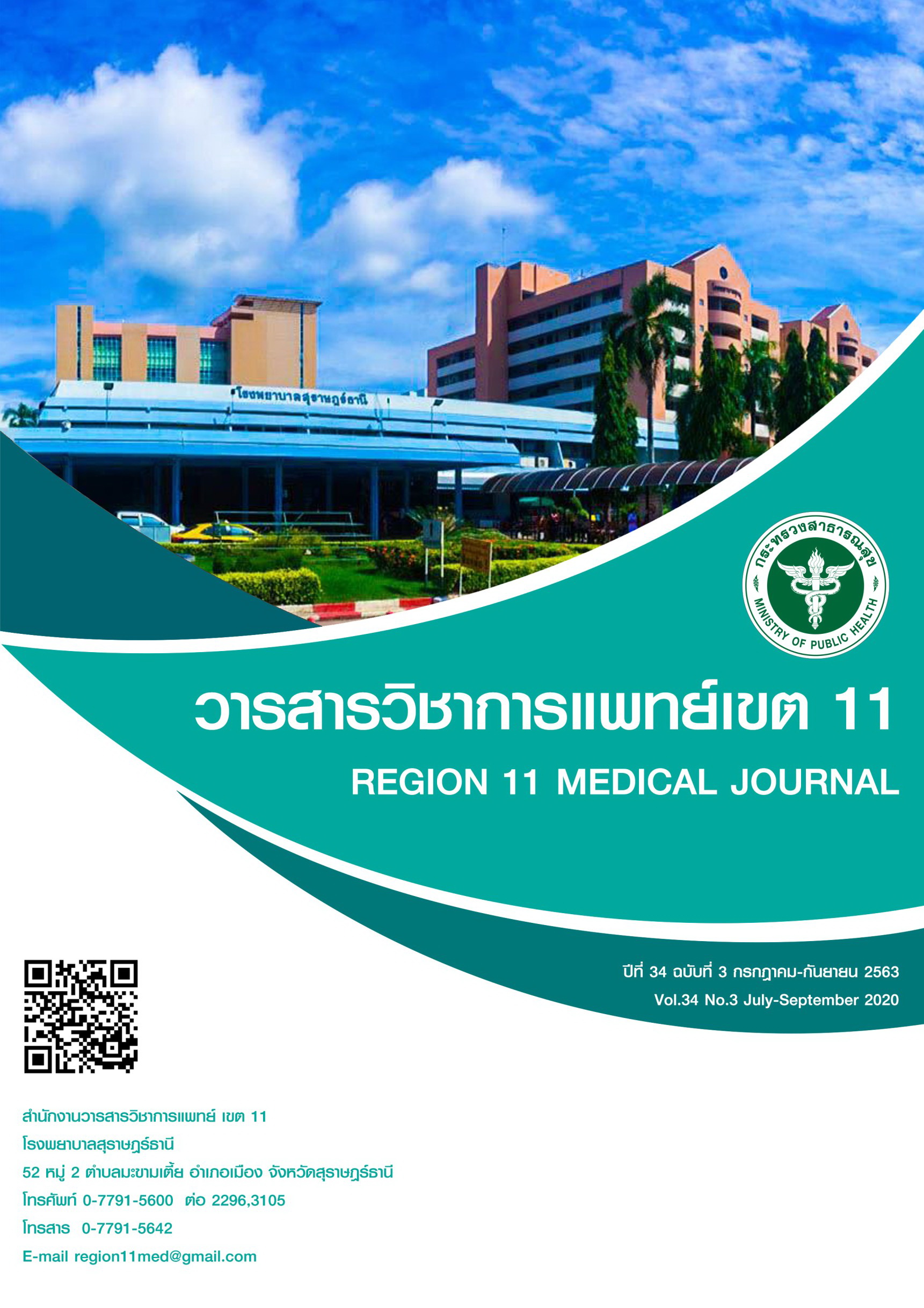Outcome of Using Clinical Practice Guideline for Sepsis in Trang Hospital
DOI:
https://doi.org/10.14456/reg11med.2020.3Keywords:
clinical practice guideline, severe sepsis, septic shockAbstract
Background: Surviving Sepsis Campaign Guideline with Early-Goal Directed Therapy (EGDT) had empirical evidence for clinical outcome improvement by reduced mortality. Thai Guideline for Severe Sepsis and Septic Shock implemented since 2015 had the same treatment result. Trang hospital adopted Severe Sepsis Guideline in 2017 but no previous studied to determine the efficacy.
Objectives: Compare treatment outcomes before and after implementation of Clinical Practice Guideline for Severe Sepsis in Trang hospital. Primary outcome was mortality rate, secondary outcomes were length of hospital stay, medical expenses, rate of intensive care unit (ICU) admission and treatment process indicators in first 6 hrs.
Material and Method: Retrospective review of in-patient data before and after Guideline implementation. Collect demographic data, co-morbidity, site and etiology of infection, treatment process indicators, primary and secondary outcomes.
Results: 220 Patients included with 110 per each group. Mean age group 61-80 years, the most common co-morbidity was Diabetes Mellitus and site of infection was genitourinary tract in both groups. Started antibiotic within 1 hour 85.5 % in before guideline group and 82.7 % in after guideline group, adequate fluid resuscitation71.8 % in before guideline group and 79.1% in after guideline group ,increase amount of total fluid in after guideline group from 1,703.3 ± 59 ml. to 1,779.1 ± 51.1 ml and administration of inotropic drug 91.8% in first 6 hrs for both groups. Statistically decreased mortality in after guideline group 31.82 % compared with 49.09 % in before guideline group Increased length of stay from 6.39 ± 0.66 days to 7.63 ± 0.76 days in after guideline group, also increased medical expenses in after guideline group with slightly increased rate of intensive care unit admission .Rate of guideline used was 36 percent.
Conclusion: Clinical Practice Guideline for Severe Sepsis in Trang hospital improved clinical outcomes by reduced mortality although unable to reduce length of stay and lower medical expenses. Encourage more users increase therapeutic benefits in the future.
References
Rivers E, Nguyen B, Havstad S, Ressler J, Muzzin A, Knoblich B, et al. Early goal-directed therapy in the treatment of severe sepsis and septic shock. New England Journal of Medicine. 2001;345(19):1368-77.
Survivingsepsis.org. Surviving sepsis Campaign [Internet]. 2015 [cited 2020 April 28). Available from: https://www.suevivingsepsis.org/Bundles/Pages/default.aspx.
Micek ST, Roubinian N, Heuring T, Bode M, Williams J, Harrison C, et al. Before–after study of a standardized hospital order set for the management of septic shock. Read Online: Critical Care Medicine| Society of Critical Care Medicine. 2006;34(11):2707-13.
Kortgen A, Niederprüm P, Bauer M. Implementation of an evidence-based “standard operating procedure” and outcome in septic shock. Critical care medicine. 2006;34(4):943-9.
สมาคมเวชบำบัดวิกฤตแห่งประเทศไทย. แนวทางเวชปฏิบัติการดูแลรักษาผู้ป่วย severe sepsis และseptic shock (ฉบับร่าง) พ.ศ. 2558 [อินเทอร์เน็ต]. 2558 [เข้าถึงเมื่อ 28 เมษายน 2563]. เข้าถึงได้จาก: https://www.scribd.com/document/308976515/ร่างแนวทางเวชปฏิบัติ-sepsis-และ-septic shock -2558.
Permpikul C, Tongyoo S, Akekarin P. In-hospital outcome of septic shock patients after guideline directed management implementation: the significance of initial volume replacement. Proceedings of Siriraj- Ramatibodi Medical Congress to commemorate the 60th Anniversary Celebration of His Majesty’s Accession to Throne. 2006:18-21.
Permpikul C, Tongyoo S, Ratanarat R, Wilachone W, Poompichet A. Impact of Septic Shock Hemodynamic Resuscitation Guidelines on Rapid Early Volume Replacement and Reduced M. J Med Assoc Thai. 2010 Jan 1;93(1):S102-109.
Angkasekwinai N, Rattanaumpawan P, Thamlikitkul V. Epidemiology of sepsis in Siriraj Hospital 2007. J Med Assoc Thai. 2009 Mar 1;92(Suppl 2):S68-78.
กรมควบคุมโรค กระทรวงสาธารณสุข. รายงานสถานการณ์โรคฉี่หนู [อินเทอร์เน็ต]. [เข้าถึงเมื่อ 2 พฤษภาคม 2563. เข้าถึงได้จาก http://www.boe.moph.go.th/boedb/surdata/disease.php? dcontent=old&ds=43.
ดวงมณี เลาหประสิทธิพร. Clinical tracer เรื่องการดูแลผู้ป่วยผู้ใหญ่ที่มีภาวะ severe sepsis/septic shock โรงพยาบาลศิริราช คณะแพทยศาสตร์ศิริราช พยาบาล มหาวิทยาลัยมหิดล. ใน:
สุณีรัตน์ คงเสรีพงศ์, ดวงมณี เลาหประสิทธิพร, บรรณาธิการ. แนวทางการรักษาผูปวยผูใหญที่มีภาวะ severe sepsis/septic shock โรงพยาบาลศิริราช คณะแพทยศาสตรศิริราชพยาบาล มหาวิทยาลัยมหิดล (ฉบับปรับปรุง พ.ศ. 2556). กรุงเทพฯ: มหาวิทยาลัยมหิดล. 2557:1-6.
Tongyoo S, Viarasilpa T, Permpikul C. The impact of intensive care unit admissions following early resuscitation on the outcome of patients with severe sepsis and septic shock. J Med Assoc Thai. 2014;97(1):S69-S76.
Permpikul C, Tongyoo S, Viarasilpa T, Trainarongsakul T, Chakorn T, Udompanturak S. Early use of norepinephrine in septic shock resuscitation (CENSER). A randomized trial. American journal of respiratory and critical care medicine. 2019 May 1;199(9):1097-105.
ชูหงส์ มหรรทัศนพงศ์. ผลลัพธ์ของ Surin sepsis treatment protocol ในการจัดการดูแลรักษาภาวะติดเชื้อในกระแสเลือด. ศรีนครินทร์เวชสาร. 2555;27(4):332-9.
จิรารัชน์ อุนนะนันทน์. การประเมินแนวทางปฏิบัติการรักษา ภาวะติดเชื้อในกระแสเลือดชนิดรุนแรงในโรงพยาบาลอ่างทอง. วารสารวิชาการ รพศ/รพท เขต4. 2557;16(3):184-91.






